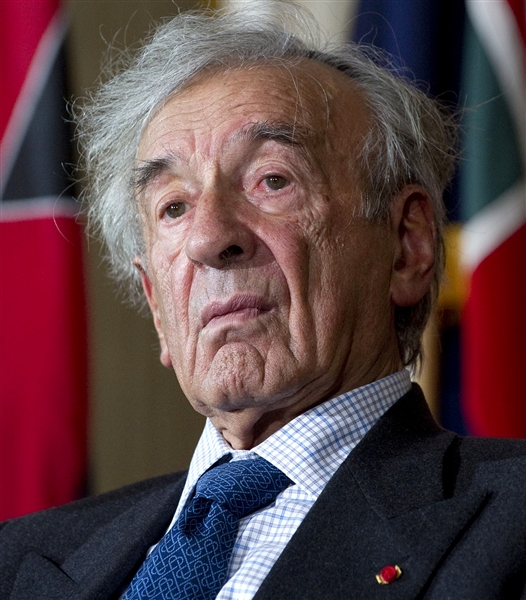Blog
Jews and their lies
Written on April 10, 2013 at 4:00 pm, by Carolyn
By Carolyn Yeager
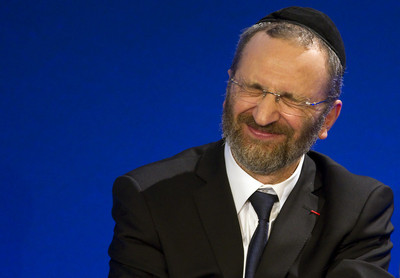 Just recently, the Chief Rabbi of France, Gilles Bernheim, has admitted to plagiary and lying about it.
Just recently, the Chief Rabbi of France, Gilles Bernheim, has admitted to plagiary and lying about it.
He is a 60 year-old “trained philosopher” who was elected in 2008 as the religious leader of the third-largest Jewish community in the world, numbering approximately 600,000. (Note the two symbolic sixes in the foregoing.) At issue were several parts of his book Forty Jewish Meditations that were found to be taken from other sources.
Right: The Great Rabbi of France Gilles Bernheim attends the UMP party‘s debate on secularism in Paris, France, April 5, 2011. No, he’s not blind, maybe just exhibiting his affinity for denial.
The plagiarizing is one thing; the trail of lies this flawed man came up with to deny it is the real scandal. Just last December, Pope Benedict XVI quoted from a recent essay by Bernheim on same-sex marriage; now there are charges that parts of that essay, too, were similar to the work of others. On Monday, a French Web site, Archeology of Cut and Paste, accused the rabbi of using passages in his essay that were close to those in a book by a priest, the Rev. Joseph-Marie Verlinde. No wonder the Pope liked it!
The exposure of the plagiarism started in March (last month) when a website named Strass de la philosophie discovered similarities between Bernheim’s work and an interview of the philosopher Jean-François Lyotard in the 1996 book Questioning Judaism by Elizabeth Weber.
A few days later, in a childish, yet cynical attempt to cover for himself, Bernheim answered by saying that some of the meditations in the books were transcripts of lessons he gave in the 1980s, as a chaplain for Jewish students, and that these lessons were often recorded while copies of his personal notes were handed to pupils – thus implying that Lyotard, who died in 1998, plagiarized him, and not the opposite.
But Elizabeth Weber subsequently refuted Bernheim’s version, saying that Lyotard had answered her questions without any notes. Also, Jean-Noel Darde, a senior lecturer at Paris 8 University, who runs a website that specializes in academic plagiarizing, suggested that the Chief Rabbi might have also used fragments of other books, written well before the 1980s, by authors such as Elie Wiesel, Jean-Marie Domenach and Charles Dobzynski.
Faced with this, the rabbi then blamed inadequate oversight of a student who did some of the writing. He said he had hired the student because of a busy schedule and had not informed his publisher of the arrangement. “It is the one and only time I made such an arrangement,” he wrote in a statement. “It was a terrible mistake. I have been fooled. However, I am responsible.” He also apologized for initially denying the accusation, calling his reaction “emotional, hasty and clumsy.” He said. “I retrospectively analyze it as denial.”
However, further proof of the man’s lying nature emerged when it was shown that Rabbi Bernheim had claimed an academic achievement that he had not earned. His Who’s Who entry, based on information he provided, says he was awarded from the Sorbonne an “agrégation de philosophie,” an elite and highly competitive academic distinction. But there is no record that he won such an honor. (Who does that remind you of?)
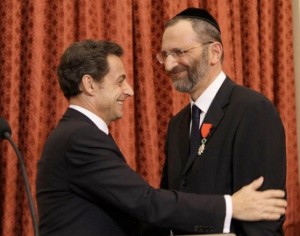 Left: Bernheim with former French President Nicolas Sarkozy, also a Jew, who awarded him the Legion of Honor in 2010. Sarkozy said twice that Bernheim is an “agrégé de philosophie,” a very competitive academic distinction in France. Bernheim did not contradict him.
Left: Bernheim with former French President Nicolas Sarkozy, also a Jew, who awarded him the Legion of Honor in 2010. Sarkozy said twice that Bernheim is an “agrégé de philosophie,” a very competitive academic distinction in France. Bernheim did not contradict him.
There is growing pressure for Rabbi Bernheim to resign, but in a radio interview Tuesday night, he said he would not step down, adding that although he had made mistakes, “I have not committed fault in the exercise of my functions” as France’s chief rabbi. [UPDATE: On Thursday, the rabbi-in-denial faced reality and resigned. See here.]
At the same time, some fellow Jews rush to defend him. Richard Prasquier, a friend of the rabbi and president of the Representative Council of Jewish Institutions of France, appealed to him to set the record straight and spoke movingly of the “torment” the rabbi must feel. Oy vey.
“Gilles Bernheim is my friend,” Dr. Prasquier said in an editorial on Tuesday in the organization’s newsletter. “A life like his cannot be hostage to a few failures in an area of intellectual or academic qualification related to his activity as a rabbi.” Dr. Prasquier said Rabbi Bernheim ought to be able to continue in his job, “where he has presented, in an eloquent voice, a Judaism open to the city and rigorous in its principles.”
The position of Chief Rabbi of France comes via the Centrale Consistoire, which was created in 1808 by Napoleon to oversee Jews in France. It was intended to make sure the unruly Jews followed the laws of France concerning military service, especially, and should take up mechanical trades; but that was lost sight of long ago.
Nobody ever said that Jews held high standards for themselves. The fact that Bernheim told pathetic lies implicating innocent persons in wrong-doing that he knew was his own doing, is inexcusable in a religious leader of any rank, let alone the highest rank. However, lying about his record at the Sorbonne, giving himself high academic distinctions that were never his, is actually typical Jewish behavior. We see it with Elie Wiesel, too.
How does this relate to Elie Wiesel, or to Kenneth Waltzer?
It relates to Jews who hold respectable, responsible positions in society, who are not really qualified, in spite of degrees from the Sorbonne or Harvard. These men WILL make mistakes and will cheat. In the case of Wiesel, every degree he has is honorary, and not much is expected of him. But in the case of Waltzer, he’s expected to demonstrate serious academic ability which, so far, he has not. I will be returning to this theme, and to three photographs which have been claimed to be Elie Wiesel, that are tied to key elements in the story of Elie in Buchenwald. These three photographs can be seen here, here and here. All three have been mislabeled, and there is no effort at all to correct the record. Just as there has been no effort to answer to Verena Dobnik’s false claim that she saw Elie Wiesel’s “death camp” tattoo during her interview of him in October 2012.
All of this will be tied together under the banner of perpetual lies by people in high places. But to what degree is Elie Wiesel the source of them? Who is running the show?
Note: The information about Bernheim for this article came mostly from The New York Times and Worldcrunch.com.
Is it time to call Ken Waltzer a fraud?
Written on April 1, 2013 at 7:24 am, by Carolyn
By Carolyn Yeager
copyright 2013 Carolyn Yeager
Updated April 7th
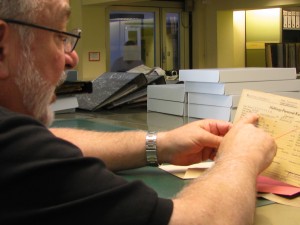
Prof. Kenneth Waltzer is looking at a Buchenwald registration card at the International Tracing Service in Bad Arolsen, Germany.
Kenneth Waltzer is a professor of history at Michigan State University since the early 1970’s. He helped to create the Jewish Studies program which opened in 1992, and which he heads. Waltzer has been researching into evidence of a special ‘boy’s protection program’ run by prisoners at Buchenwald for going on 10 years now. As an “approved” researcher, he is allowed to peruse all the files at the International Tracing Service in Bad Arolsen, Germany, something that is made much more difficult, if not impossible, for revisionists.
Waltzer is considered one of the top scholars in the U.S. of the ill-named holocaust but his work has been sloppy, and his attempts to cover up the sloppiness amount to fraud. This, along with his continual promotion and defense of Elie Wiesel as a Buchenwald survivor, is what has drawn me to study him ever more closely.
Because of the seriousness of the charge I am making against him, I will list right up front my reasons for thinking it is time for such a call. They are:
- Waltzer habitually tells fibs in the form of false information which is intended to mislead. When called out for it, he tells more fibs to cover for the first ones.
- He has been in the service of the “Holocaust Industry,” not academic rigor and fair-mindedness, from the very start of his career.
- He knowingly defrauds his students, his university and the public (you and I) with his dishonest “holocaust scholarship.”
- While he is drawing high pay as a tenured American professor of history at MSU, he is working to advance the State of Israel.
I am going to show that these charges have a strong basis in fact. Fraud is commonly understood as dishonesty calculated for advantage. A person who is dishonest may be called a fraud. In the U.S. legal system, fraud is a specific offense with certain features. (see here)
Legally, fraud must be proved by showing that the defendant’s actions involved five separate elements: (1) a false statement of a material fact, (2) knowledge on the part of the defendant that the statement is untrue, (3) intent on the part of the defendant to deceive the alleged victim, (4) justifiable reliance by the alleged victim on the statement, and (5) injury to the alleged victim as a result.
I am not intending to bring legal charges of fraud against Prof. Waltzer, but to try him in the court of public opinion. Therefore, it will be up to Waltzer to defend himself against my charges.
* * *
Two years ago, I asked the question on this web site: “What happened to Ken Waltzer’s book about the boys of Buchenwald?” It was claimed to be, at that time, in it’s final stages. Eight years after he publicly announced he was researching for a book about the so-called children’s barracks at Buchenwald (Barracks #66 ), it still has not materialized. Five years after his book was described as “upcoming,” it still has not materialized. During this time, he has not produced another book, or any major work that would have taken precedence over this book. So what is the delay?
It’s pretty plain that the book’s thesis has shifted considerably since 2005, when his MSU website featured Elie Wiesel as the most recognizable and famous child survivor from Buchenwald. That website was taken down between one and two years ago and is completely wiped clean from the Internet. The banner on all the six to eight pages that were included showed a photograph very similar to the one below of the “boys” being marched out of the main Buchenwald camp to temporary quarters at the former SS barracks.
The USHMM (national holocaust museum in D.C) website dates this picture as being taken on April 17, 1945, six days after liberation.1 At this time, Elie Wiesel, by his own account in two books, was laying in a hospital sick almost unto death from food poisoning. Details like this don’t deter Prof. Waltzer from backing up in every instance the standard holocaust narrative. “Elie Wiesel in Buchenwald” is the standard narrative, so evidence must be found for it.
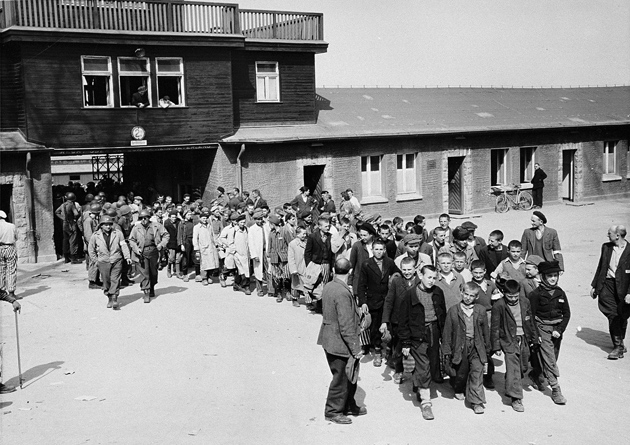 Ken Waltzer claimed for years that one of these boys was Elie Wiesel. But Wiesel is not in this picture!
Ken Waltzer claimed for years that one of these boys was Elie Wiesel. But Wiesel is not in this picture!
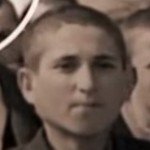 From at least 2005 (eight years now), Waltzer has identified the boy third or fourth from the front (hard to tell) in the left-side column (dressed in a black suit and in front of the tall boy wearing a beret) as Elie Wiesel, based on nothing but his own fraudulent intention that there was enough resemblance that people would believe it if he said so. In this article , I exposed this lie. Waltzer has never admitted that he was mistaken or was perpetrating a falsehood that he intended to put into his book. Instead, what he did when his fabrication was sufficiently exposed was to take the entire site down and not mention it again.
From at least 2005 (eight years now), Waltzer has identified the boy third or fourth from the front (hard to tell) in the left-side column (dressed in a black suit and in front of the tall boy wearing a beret) as Elie Wiesel, based on nothing but his own fraudulent intention that there was enough resemblance that people would believe it if he said so. In this article , I exposed this lie. Waltzer has never admitted that he was mistaken or was perpetrating a falsehood that he intended to put into his book. Instead, what he did when his fabrication was sufficiently exposed was to take the entire site down and not mention it again.
Left is a close-up of the boy Waltzer has maintained for several years is Elie Wiesel. Anyone can tell it is not and that’s why no one else ever publicly agreed with him.
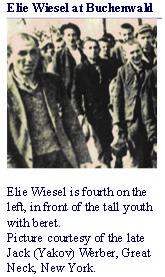 I have some of what was on that site copied into articles here at EWCTW and also in my files. At left is the cropped section of the photo that Waltzer used on the banner of his MSU-Newsroom/Holocaust website that was very much dedicated to Elie Wiesel. (Another reader, Chris, informed me that he had found pages from the site using the Way Back Machine. Many thanks to him.) This shows that Waltzer definitely identified the boy in the black suit as Elie Wiesel. In addition, Jack Werber, a known dishonest survivor, was the supposed supplier of the picture.
I have some of what was on that site copied into articles here at EWCTW and also in my files. At left is the cropped section of the photo that Waltzer used on the banner of his MSU-Newsroom/Holocaust website that was very much dedicated to Elie Wiesel. (Another reader, Chris, informed me that he had found pages from the site using the Way Back Machine. Many thanks to him.) This shows that Waltzer definitely identified the boy in the black suit as Elie Wiesel. In addition, Jack Werber, a known dishonest survivor, was the supposed supplier of the picture.
Below right, a screen shot of one of the pages as it existed then, sent by a friend of EWCTW. It shows more of the emphasis on Elie Wiesel.
When I pointed out much of this in a podcast of March 25th, Waltzer sent me an email on March 28th stating,
My websites at UM FLint are down because I was appointed there one year and am now back at Michigan State.
Of course I never mentioned UM Flint and never even saw his website there. I was speaking about his MSU website, which was titled something like Ken Waltzer’s “MSU Newsroom Special Report.” It was full of information about his projects and especially what he calls “the rescue operation of children at Buchenwald.” It was up on the Net since at least 2008 2, then suddenly disappeared, with not even cache pages to be found. Did Waltzer tell me a fib, or did he just read the podcast program description and misinterpret what it said about “taking down web pages?” By now, he will know what I mean and may answer.
 I think it is very possible that he timed the take-down of his MSU “Newsroom” site with his one-year visiting professorship at UM Flint — putting up a temporary website there which he could take down when he left. This is a way of confusing the picture in order to distract as much as possible from his more recent decision to put more distance between himself and his prior (false) assertions about Elie Wiesel.
I think it is very possible that he timed the take-down of his MSU “Newsroom” site with his one-year visiting professorship at UM Flint — putting up a temporary website there which he could take down when he left. This is a way of confusing the picture in order to distract as much as possible from his more recent decision to put more distance between himself and his prior (false) assertions about Elie Wiesel.
His intention was and is clearly to deceive. The harm is caused to ordinary people who believe and trust that they are getting knowledgeable answers from a professor of history and a holocaust scholar. In this particular case, all five of the elements necessary to prove fraud are there.
First, he sets up a University-sponsored website maintaining falsely that Elie Wiesel is the boy in the photograph of youthful “survivors” marching out of the camp (1). He knows it is false because he has no evidence or proof, only his own “wishful thinking.” The USHMM never identified Wiesel in that group of boys, nor did anyone else (including Wiesel himself), unless they did so from following Waltzer’s example (2). Waltzer’s intent was to make the public believe something that was not true – that he had proof of Elie Wiesel being one of the “rescued children” (3). Because Waltzer is a Professor of History and “holocaust expert” at a major university, and is at all times written up very favorably in the media, the public (you and I ) and his students will rely on his statements (4). These same students and public are injured when photographs are mislabled in order to foist on them a certain belief about an influential historical event that affects their entire world view (5).
* * *
This is just one instance of the untruths that Ken Waltzer has told over the years. Another tactic he uses is to promise an upcoming answer to your doubts which he cannot or does not produce now. As we have seen, we continue to wait as he continues to promise. Still another tactic is to accuse others of lying when it is he who is doing so. But only people who are knowledgeable enough about these complex and purposely obscured issues can see who is doing the lying. In this same email, he wrote:
The book is on track, and I have also completed a separate essay to be published on Elie Wiesel and Buchenwald.
Completed, he says. And separate. Why separate? I wrote back to him asking where I could find his essay because I wanted to read it. No reply – which is typical because factual information is not his forte, emotional rhetoric is. I feel it’s quite possible he wrote a separate essay on Elie Wiesel so as not to tarnish his book with the false “facts” about Wiesel in Buchenwald. He can always get rid of an essay, if necessary, later – but not his entire book. What might there be in this essay? Will it be the same or quite different from what he wrote in a March 6, 2010 comment at Scrapbookpages Blog, when he said [my underlining-cy]:
For the skeptics [I was using the name skeptic then -cy] and know-nothings who have written in suggesting Eli Wiesel was not in the camps, that Night is purely fiction, you are all dead wrong. The Red Cross International Tracing Service Archives documents for Lazar Wiesel and his father prove beyond any doubt that Lazar and his father arrived from Buna to Buchenwald January 26, 1945, that his father soon died a few days later, and that Lazar Wiesel was then moved to block 66, the children’s block in the little camp in Buchenwald. THese documents are backed up by military interviews with others from Sighet who were also in block 66, and by the list of Buchenwald boys sent thereafter to France. All of this is public domain.
Wishful thinking by Holocaust deniers will not make their fantasies true. While Wiesel took liberties in writing Night as a literary masterpiece, Night is rooted in the foundation of Wiesel’s experience in the camps. The Buchenwald experience, particularly, runs closely to what is related in Night.
Comment by kenwaltzer — November 14, 2010 @ 6:57 am
How much untruth is contained in this, in order to defraud us all in his devoted service to the “Holocaust Industry” and the state of Israel? Plenty. As proof that Elie Wiesel was in Buchenwald, he points to documents for Lazar Wiesel and “his father.” It is even more absurd because Lazar Wiesel’s relative was only 13 years older than Lazar – it was in fact his brother Abram! Waltzer is passing off Lazar for Elie simply on the basis that Lazar also came from Sighet, Elie’s hometown and carries the same name. Sighet was a city of 50,000 or so with a very large Jewish population, and Wiesel was a common name. But the “scholar” who has taken years to research this and still isn’t finished, wants us to believe there can be only one Lazar Wiesel, who is Elie. He attributes the difference in their birthdates to bureaucratic error.
Previously I may have called this stupidity, but now I’m calling it fraud, based on the above-given definition. Of course Waltzer can see the discrepancies here, but he hopes he can convince you not to see them. The Military Interview mentioned with Lázár Wiesel’s name on it also does not have the right birthdate for Elie Wiesel, nor does the signature match Elie’s well-known signature.
Will Waltzer repeat this nonsense in his latest “completed” essay? Notice that Waltzer never fails in the name-calling department, here calling his critics names such as “know-nothings” and “Holocaust deniers.” Several months later, he wrote a similar comment at EWCTW to the blockbuster article: “Signatures Prove Lázár Wiesel is not Elie Wiesel”
On November 14, 2010 at 10:34 am
Contrary to Carolyn Yeager’s wishful thinking, Eli Wiesel was indeed the Lazar Wiesel who was admitted to Buchenwald on January 26, 1945, who was subsequently shifted to block 66, and who was interviewed by military authorities before being permitted to leave Buchenwald to go with other Buchenwald orphans to France. Furthermore, there is not a shadow of a doubt about this, although the Buchenwald records do erroneously contain — on some pieces — the birth date of 1913 rather than 1928. A forthcoming paper resolves the “riddle of Lazar” and indicates that Miklos Gruner’s Stolen Identity is a set of false charges and attack on Wiesel without any foundation.
The promise of a forthcoming paper turned out to be a fib. From Nov. 2010 to now, there has not been any paper. Maybe it’s the essay he mentioned in his March 28th email? “Forthcoming” to Waltzer means up to two and a half years, it seems. That in itself is the sign of an unreliable person.
There can be only one reason Ken Waltzer allows himself to look like a buffoon and a shyster. He doesn’t need to do it to keep his position at Michigan State University. He does it because it is his larger job to keep the Buchenwald atrocity stories and Liberation lies, including the Elie Wiesel myth, alive and well in the mind of the public. He works for purely Jewish interests – I will be writing a future article on the priority, meaning and funding of Jewish Studies programs in American universities. For now, I can add that Waltzer is more of a public relations (PR) worker for the Holocaust Industry, the State of Israel and maybe AIPAC, than he is an honest-to-god academic. Another organization connected to Israel that he serves is Scholars for Peace in the Middle East. He has written four attack-dog articles for them since 2009, functioning in a sort of Abe Foxman-pitbull style.
In Nov. 2009, he attacked Alison Wier as another “know-nothing” because she speaks up for Palestinian rights on college campuses, where she is popular.
In May 2010, he went after John Mearsheimer for calling Israel “an apartheid state” and also took out after Noam Chomsky, Norman Finkelstein, and “the crackpot Phil Weiss.”
Also in May 2010, another target was Judith Butler, who campaigned at the Berkeley campus for the university “to divest from companies making military weapons which Israel employs to commit war crimes.”
In August 2011, he wrote on the Israeli-Palestinian peace process, arguing for Israel’s interests to be well and strongly presented on college campuses.
But this is only the tip of the iceberg when it comes to Walzer’s pro-Israel activities. I will be writing further articles that present the evidence for Ken Waltzer being guilty of fraud in his public writings and during his entire career. Much of it revolves around Elie Wiesel and the Industry’s need to place him at Buchenwald. My position, if you have somehow missed it, is that Elie Wiesel was never at Buchenwald. I am also saying that Waltzer is backing down or “stepping back” from his blatant, dishonest claims about Wiesel, but he can’t back down altogether.
Endnotes:
1. I have also seen it dated April 27 at the USHMM and have used that date in other articles here. Now I have only found this one picture which is very officially dated the 17th. There may have been an attempt to move the date to the 27th so that Wiesel could be in the picture (though he supposedly would not have been released from the hospital until the 28th). It is really too bad the USHMM cannot be relied upon; nor can Yad Vashem. When the museum “researchers” are involved in lying or in complacency, one really has nowhere to turn.
2. http://msutoday.msu.edu/news/2008/mapping-the-holocaust-archive-msu-prof-explores-records-of-nazi-atrocities At bottom of article, it reads “For more information, and to follow Waltzer’s research and read his journal as he participates in the workshop, visit the special report at: http://special.newsroom.msu.edu/holocaust.” This is a link to the website that no longer exists, as you will see if you click it. Now he seems to be pretending it was never there.
Elie Wiesel Goes Home Video
Written on March 22, 2013 at 1:14 am, by admin
Does Elie Wiesel speak Hungarian?
Written on March 21, 2013 at 3:21 pm, by Carolyn
By Carolyn Yeager
copyright 2013 carolyn yeager
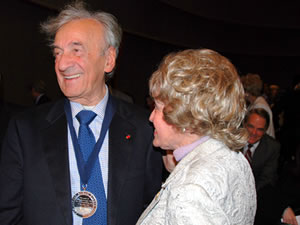 The answer might be: Barely. Or rudimentarily.
The answer might be: Barely. Or rudimentarily.
Elie Wiesel is known for putting big ones over on the American (and other English-speaking) people, so it is no surprise to us that he is also faking his knowledge of Hungarian. I had already noticed that, on the rare occasions he is shown speaking that language, he doesn’t go beyond short phrases or even just one-or-two-word questions and answers. Not being linguistically gifted myself, I didn’t feel I could say much about it.
Image right: The pretentious Tom Lantos Human Rights Prize for 2010 was presented to the pretentious Elie Wiesel (shown with Lantos’ widow) in November 2010. [Photo by Babette Rittmeyer & Brittany Smith] More about Tom Lantos below.
But now a Hungarian-American reader named John contacted me about the video “Elie Wiesel Goes Home.” He began by watching the short segment (2 min 29 sec) that is available on Youtube. He noticed discrepancies right away.
According to John:
Wiesel is speaking Hungarian words, but they are not spontaneous and his “inflections” are all wrong. The person he is speaking with IS speaking spontaneously, with proper Hungarian (very language specific) inflections, and using the proper idiomatically correct sentence structures. Wiesel is speaking in a short, pressured, and monotone manner – more like if a foreign-born person would have studied a travel guide.
Also, Wiesel’s accent while speaking English is not like a native Hungarian who is speaking English. Listen to former Senator Tom Lantos – he was from Hungary and also of Jewish descent; his accent, while speaking English, has the distinctive Hungarian characteristics that I am familiar with.
John told me why he thinks he is a competent judge of Wiesel’s language skills:
I was born in Hungary and escaped from there in 1956. I am fluent in Hungarian (without any accent) and I am fluent in English (without any accent). I was educated both in the U.S. and (some) in Europe, I have traveled a lot and I understand “cultural idioms.”
In his first message to me, John detailed a few translation errors in the video segment.
Video captions vs. the correct translation:
@48 seconds into the video the caption reads “This is the most important” – the correct translation is “This is the most interesting”@ 54 seconds into the video the caption reads “A farewell letter. When they knew they’d be taken away.” – the correct translation is: “This is a farewell letter, [written] while they were already waiting, to take them away”
@ 57 seconds into the video the caption reads “I had a Christian employee” – the man simply says “I had an employee.”
John then did an exact word for word comparison of the captions on the film segment versus what was actually spoken between the two men. The Hungarian is showing some family photos to Wiesel as they speak. What we notice is that Elie Wiesel said very little, and at times the Hungarian man didn’t seem to understand Wiesel’s words. In order to demonstrate that, I will now copy just the actual words that passed between the two, leaving aside the captions. Wiesel’s speech is in blue boldface.
My brother’s family. You said you knew them?
Yes.
This is with his wife. His children, my oldest brother, who might have known you. [Note that Wiesel does not answer.-cy]
And, ah, did they go to Auschwitz?
What’s that?
They went to Auschwitz.
Everyone. They don’t exist to anyone. I would remember. They don’t exist.
This is my mother.
Mother. Did she die here in Sighet or Auschwitz?
Iske died in Sighet, she lived until ’34.
This is our entire family … as we were [as all of us that were around].
And this?
This. This is the most interesting. This … is a farewell letter, while they were already waiting, to take them away.
Yes.
Then … I had an employee … [Wiesel interrupts as if he doesn’t know what was said about the employee.-cy]
They didn’t know about Auschwitz.
They didn’t know, of course no one knew, and it came to us [later] what was to be.
Then they, the children, wrote me a farewell letter, because they knew then that … I had sent the man from the forests to find out what’s going on … [“forests” could refer to a region, i.e. Transylvania in Hungarian is “Erdély” meaning “The Forests” – John] and afterwards, on the last day, they sent me this letter — that the children, he, his wife and my father say farewell to me.
This is very important.
Yes.
Wiesel turns to one of his crew near him and says in English: “This is a collective letter of farewell that the entire family wrote to him the day of the deportation, this is very important.”
This is very important.
Yes. From the content you’ll see —
Exactly.
what kind of mood, sadness, they didn’t know what was going to happen … they were sitting on their luggage and waited for them to come … poor things … and then, well, the rest of it we already know … we didn’t know what would be desired to happen, or what will happen. I told all of this stuff to Militka in English.
No one came back?
What?
No one came back?
No one in the world.
No one.
There would still be a lot more, but these are the most important. I am very happy for this because it would have been lost.
This … it was left.
It is clear from this that Wiesel’s part in this conversation consists of very few words, spoken repetitively. Add to this the claim by Nikolaus Grüner that Wiesel declined to speak with him in Hungarian when they met in Stockholm in 1986, and other situations wherein Wiesel had the opportunity to show off his Hungarian but didn’t … and we have to assume that he is simply unable to speak it with any fluency.
What else can explain Elie Wiesel’s lack of understanding of the Hungarian language?
As I have written in earlier articles, Elie Wiesel did not like public secular school, but he loved Jewish religious school. As a youth, he often played sick and missed school. Yiddish was the common language spoken in the home and in the community. Wiesel learned Hebrew and devoted himself to the Talmud and other Jewish religious texts. He did not like Gentiles and avoided them; Hungarian was the language of the enemy. Later, at age 17 (or earlier?) he went to France and became a French speaker.
But why doesn’t he just say so? Why does he prefer to give people a false impression about himself? Is this just another aspect of his need to lie — to make up stories, to see that which didn’t happen as if it did happen, and that which did as not having happened? Is Elie Wiesel just an inveterate, or compulsive, liar?
“Holocaust survivors” are mostly people who tell lies. The late Senator Tom Lantos (below left) is a good example. It turns out that he and Elie Wiesel are the same age — both born in 1928, in February and September respectively, and according to their own accounts (no other confirmation) were arrested in Spring 1944 in the Jewish round-up in Hungary. Wiesel says he was sent to Auschwitz and got tattooed, along with his father. Lantos tells a different story.
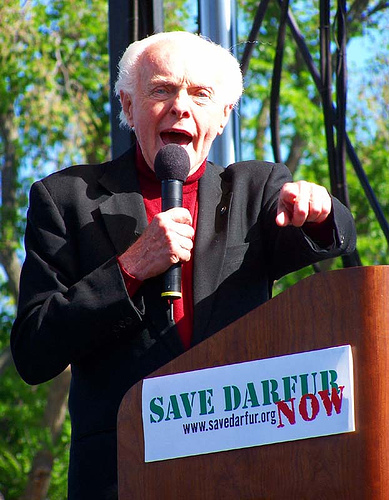 Is there any reason to believe the story Tom Lantos tells of being a “holocaust survivor?”
Is there any reason to believe the story Tom Lantos tells of being a “holocaust survivor?”
Tom Lantos was born in 1928 (same year as Elie Wiesel) to a Jewish family living in Budapest. According to his Foundation biography, “as a teenager he was sent to a forced labor camp by the German Nazi occupant military. After escaping the labor camp, he sought refuge with an aunt who lived in a safe house operated by Raoul Wallenberg …”
Wikipedia (Ref. #8) uses the Biography Channel as the source for Lantos’ holocaust survival story:
In March 1944, [Lantos] was sent to a labor camp in Szob, a small village about 40 miles north of Budapest. He and his fellow inmates maintained a key bridge on the Budapest-Vienna rail line. Lantos escaped, was captured and beaten, then escaped a second time and returned to Budapest.
Do we know that Lantos was not paid for this labor – as so many were – but still “ran away” and returned to Budapest, where he met up with some form of resistance organization? No we don’t. No research has been done; no proof or records of any of this has been presented. It is simply accepted that Tom Lantos is a holocaust survivor and entitled to the sympathy and prestige that accompanies that status, plus payments for life from the “perpetrators.” His Foundation biography continues:
“After the Russians liberated Budapest in 1945, Tom tried to locate his mother and family members but came to realize that they had all perished …”
Tom was in Budapest all that time and didn’t try to locate his mother?! His story is that he was “able to move around freely due to his having blond hair and blue eyes, which to the Nazis were physical signs of Aryanism” … as if the German police were even in Budapest and, if they were, would be unaware that Jews could also have blond hair and blue eyes. “As a result, he acted as a courier for the underground movement and delivered food and medicine to Jews living in other safe houses.” Naturally, he is presented as a positive figure, similar to Max Hamburger.
There is nothing finally said about what befell his family members, yet Wikipedia states, without any source or reference whatsoever, that “his mother and other family members had all been killed by the Germans, along with 450,000 other Hungarian Jews during the preceding 10 months of their occupation.” Believable? The source of all this can only be Tom Lantos himself, who has already been outed (by Eric Hunt, for one, in his film “The Last Days of the Big Lie“) as a practiced liar in hearings about Iraq on Capitol Hill. But heck, we all know …
His experiences in the Holocaust and afterward were highlighted in the Academy Award winning documentary The Last Days (1998) produced by Steven Spielberg‘s Shoah Foundation.
Some things we can learn from all this:
- Sixteen-year-old boys in Hungary were just as likely to be sent directly to nearby labor camps, and not to Auschwitz, in which case they would NOT have been tattooed with an Auschwitz camp number. This could explain something about Elie Wiesel.
- It was not too difficult in 1944 to escape custody and join the “resistance” without being discovered, especially if you had close relatives who had managed to avoid deportation.
- These 16-year-olds had fathers, mothers and siblings that were also capable of work, but supposedly were not sent to labor camps as Tom Lantos was, but for some unexplainable reason to Auschwitz to be killed. In any case, it is always said that none survived.
Why Doesn’t Elie Wiesel Sue Me for Libel?
Written on March 13, 2013 at 9:52 am, by Carolyn
By Carolyn Yeager
Have you ever wondered that? I sure have. If this website Elie Wiesel Cons The World is telling lies about him, it would be the natural thing to do. In the same vein, if Elie Wiesel has the number A7713 tattooed on his arm, as he says he does, it would be very easy to show it to the world and put me out of business. It is inexplicable that he doesn’t do it if he could. The only logical conclusion to reach is that he can’t … because he doesn’t.
Not only does Elie Wiesel not sue me, he doesn’t go after Nikolaus Grüner either, who called him a liar before I did. Grüner did try to sue Elie Wiesel, though, but was prevented from doing so by the courts and legal systems that protect Wiesel according to Zionist orders.
I’m told the United States Holocaust Memorial Museum closely follows this blog. I have said many negative things about the museum, too. For instance, that it is a criminal conspiracy to defraud the American people — certainly to defraud the American taxpayers out of fifty or so million dollars a year. I have accused the USHMM of blatant lying, of perpetuating false information even after it knows it is false, of creating an atmosphere of hate against anyone Jews don’t like. And, yes, of being totally run by Jews for Jewish interests — not the interests of history — very similar to the OSI (Office of Special Investigations) in it’s disreputable and downright illegal tactics.
I will be doing a new article on the relationship between these organizations — in 2010 the OSI was merged into the Human Rights and Special Prosecutions Section of the Domestic Security Section of the Justice Dept.
Elie Wiesel and the USHMM – a mutually beneficial relationship
I have previously written about the symbiotic connection between Elie Wiesel and the national holocaust museum he was instrumental in creating in this country – the USA. Built in Washington D.C. on federal ground amidst the national monuments to American history, this parasitical monstrosity pretends to be something that helps to insure the American idea of freedom and democratic principles around the world!
A faithful reader recently wrote to me:
Did you know the USHMM was closely following your blog?
Two weeks ago, I landed on the Oral History site; I did not intend to watch the VDO, but scrolling down the page, saw there was a clickable link to the transcript of the interview in .doc or .pdf format. That’s quite handy and I downloaded a couple every day till the 26th, when I posted my comment [here at EWCTW] with a link to their site on one of the rare pages without a clickable link. Guess what? – on the evening of the very same day each and every link had been disabled.
Well these testimonies have been recorded in the late 80s or early 90s, before the advent of the net and they believed they could get away with telling anything … (Bomba tells he dug a bunker in the ghetto for 50-60 people, loading it with food for 2 YEARS, apparently in a matter of days … to fifth-graders).
I am not surprised at that. I too see changes based on what is exposed on Elie Wiesel Cons The World. Just one example is Wiesel’s now more secret visits to Chapman University after I so effectively panned his first visit as a “Distinguished Presidential Fellow” in March 2011, based simply on what I read in the local and campus newspapers. We also had a fellow, Steve, pass out flyers at a Wiesel talk during that same visit. Since then, Wiesel’s visits and talks have been handled differently. In his 2012 visit to Chapman, there was no publicity and Wiesel only appeared to students in very private and secure settings. So far, there have been no announcements of his 2013 visit that I have seen.
So they react, but they are careful not to ever mention this web site or my name in any way. To object in any way about it or me would mean they would have to show, demonstrate, prove, provide evidence or give testimony that I am wrong. They know beforehand they cannot do that because they know they are the liars, not me. They depend on the news and entertainment media to keep the public believing they have noble aims.
I would have to say that Elie Wiesel and the USHMM are afraid to touch this web site because of the deep research I have done, to which they have no answers or rebuttal. Without the power of the media covering for them, and all branches of the U.S. government backing them, they would wither and die from their lack of credibility.
Their chosen method is to stay in generalities and avoid specifics
The powers that are behind Elie Wiesel and the USHMM know that they can only succeed by using generalizations like “hate,” “genocide,” “anti-Semitism,” “religious persecution,” “6 million,” etc. along with such vague “legal” language as “stirring up racial hatred” and “encouraging contempt for individuals or groups”. No legal system that has acquiesced to what the Jews want in the way of protections for themselves will allow for introduction of evidence that actually pertains to truth or falsehood of specific elements of the narrative.
Both Elie Wiesel and the USHMM make specific charges against those they call the perpetrators of evil, but they will never answer to the denial by said “perpetrators” that they committed these evils. Via the total postwar power assumed by the victors of World War II (those who brought about WWII in order to gain this power!), this question was never allowed consideration. Again, it was the media that did the job.
Legal Definition of libel
1) n. to publish in print (including pictures), writing or broadcast through radio, television or film, an untruth about another which will do harm to that person or his/her reputation, by tending to bring the target into ridicule, hatred, scorn or contempt of others.
What I do here seems to fit that (apart from the word “untruth”), but there is no response from those who are so targeted. Of course, my intention is to discover and to tell the truth, not to slander. The only complaints I get are a few comments, and once in awhile an email, from ardent fans of Elie who chastise me for being insensitive to the man’s suffering — which to their illogic means to them he can have no reason to lie about it and would only tell the truth. (And if he doesn’t, well – that is excused on the same grounds.) To their thinking, Jewish suffering excuses all moral failings. These writers are mostly female and young, appearing as though they had looked up Elie Wiesel on the Internet, come upon this site and were shocked by it. Unfortunately, these young’uns would be the first to use the “chosen method” described above, that is, to judge harm done according to “selected” peoples’ feelings. That is the only way anyone will ever touch it.

